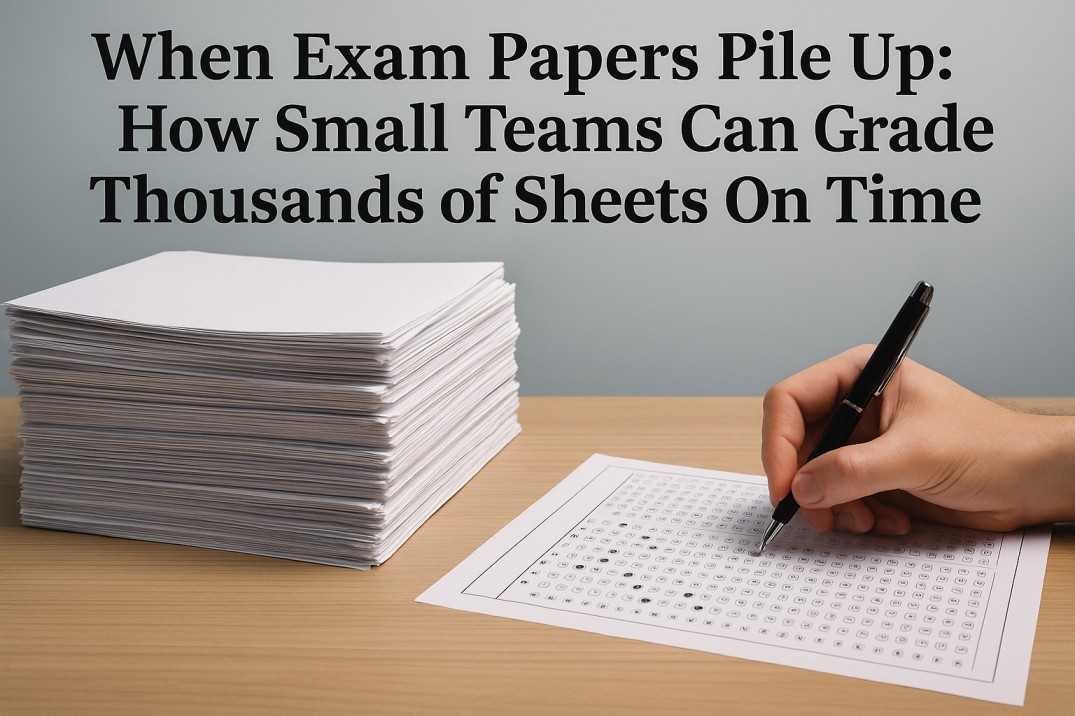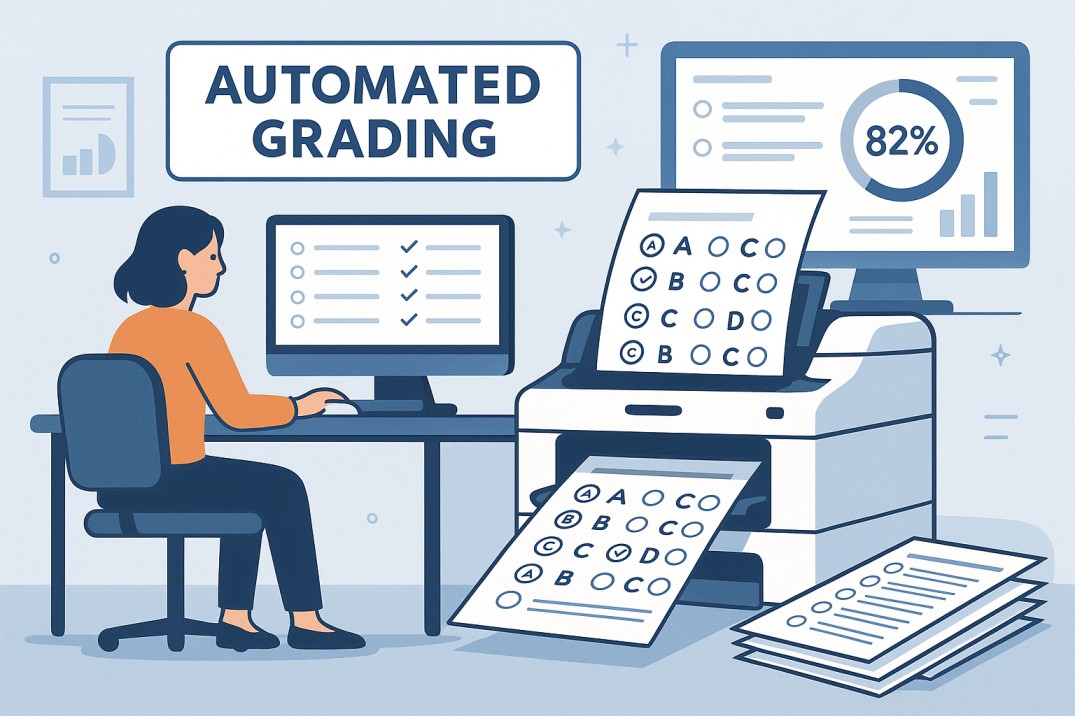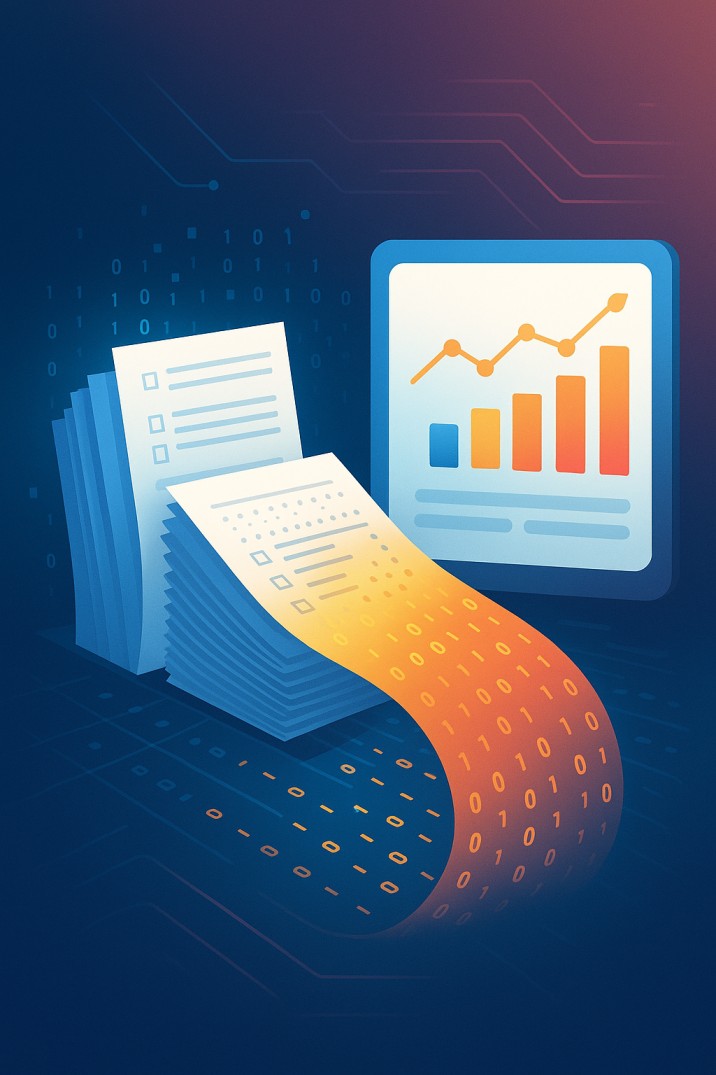
When Exam Papers Pile Up: How Small Teams Can Grade Thousands of Sheets On Time
Every school knows the scene: the term-end exams are over, and a small academic team faces a towering stack of answer sheets. With tight grading deadlines looming, teachers and administrators feel the pressure. Manual grading of hundreds (or thousands) of exam papers can take days of intense effort, often spilling into evenings and weekends. In fact, studies estimate that educators spend 20–40% of their professional time on grading-related activities– time often taken from lesson planning or personal hours. This workload is more than just inconvenient; it’s a major source of teacher stress when much of that grading time is uncompensated overtime The challenge is clear: the volume of exam sheets overwhelms small teams, and traditional methods simply aren’t fast enough.
The Challenge of Manual Grading for Small Teams
For teachers and school administrators, grading piles of exam papers by hand is a race against the clock. Each paper might take several minutes to score, and even a few hundred papers can translate into countless hours of work. Some key challenges of manual exam grading include:
Heavy Time Investment: Grading large batches of exams is slow and labor-intensive. A teacher working through 200 multiple-choice tests could easily spend dozens of hours marking answers and recording scores. This often means late nights or weekends devoted to grading, which delays feedback to students and consumes valuable time that could be used for teaching or preparation.
Stress and Burnout: The pressure to meet reporting deadlines with limited staff leads to stress and fatigue. Teachers frequently grade outside of school hours, and time spent grading is often uncompensated, contributing to high stress levels. As one report noted, grading student work is “the hardest… and most stressful” part of a teacher’s job, inducing significant uncertainty and angst. Overwhelmed staff can become demoralized, impacting the overall educational environment.
Risk of Errors and Inconsistency: Fatigue and haste can introduce human error. When manually tallying scores or deciphering answers at 1:00 AM, even the best teachers might slip up. Inconsistent grading or mistakes in scoring can creep in, potentially affecting student grades unfairly. Moreover, double-checking papers to catch errors doubles the work. Small academic teams rarely have the luxury of a second reviewer, so accuracy can suffer under heavy workloads.
The impact of these challenges is serious. Results might be delayed past the deadline, frustrating students and parents awaiting scores. Teachers, drained by the workload, have less energy for lesson planning or individualized student support. In worst cases, schools may even need to postpone progress reports or pull in extra help (at additional cost) to get through the grading crunch. Clearly, relying solely on manual methods in the face of growing class sizes and frequent assessments is becoming unsustainable.
Tight Deadlines and the Need for Speed
School administrators and education tech coordinators often emphasize one non-negotiable goal: grade hundreds to thousands of answer sheets per hour if possible. During midterms or finals, the turnaround window for grading can be just a day or two. Missing a deadline isn’t an option when report cards or university applications hang in the balance. Small teams feel this acutely—they must “meet tight grading deadlines without extra staff” or budget for overtime.
Traditional grading simply doesn’t scale to these timeframes. Consider a scenario: a high school has 500 students take a 100-question multiple-choice exam. If one teacher can grade perhaps 20-30 papers in an hour by hand (an optimistic estimate when checking answers and bubbling scores), it would take over 16 hours to finish grading 500 sheets – and that’s without breaks or interruptions. By contrast, to process thousands of sheets in an hour, schools need automation. The good news is that the technology to achieve this speed has been around for decades in large testing organizations, and it’s now more accessible than ever to ordinary schools.
Automating the Grading Process with OMR Technology
One proven solution to the grading bottleneck is automation. Specifically, many schools are turning to Optical Mark Recognition (OMR) technology – the same approach used to quickly score standardized tests. Instead of hand-marking each answer sheet, teachers can have students fill bubble-style answer sheets that a computer can read in seconds. High-speed scanners coupled with OMR software can convert stacks of completed tests into scores almost instantly.
Many institutions use bubble answer sheets (like the examples shown above) that can be scanned by computer to record answers. OMR (Optical Mark Recognition) works by detecting the marks students make on special forms, enabling an exam machine or software to grade each sheet within seconds. This approach allows even a small team to process huge batches of exams rapidly – in fact, OMR enables the hourly processing of hundreds or even thousands of documents, making very fast automated grading of exam sheets possible. The automated system reads each paper with high consistency, minimizing the chance of mistakes that a tired human might make. The result is a dramatic acceleration in grading speed with reliable accuracy.
To appreciate the impact, consider that once the answer sheets are scanned, an OMR software can read and evaluate about 100 sheets in 2–3 minutes, and advanced systems can process as many as 300–500 sheets per minute at peak performance. Even using more common equipment, it’s not unusual to scan on the order of 100 sheets per minute with an efficient OMR setup. In practical terms, what might take a teacher 10 hours of grading can be done in 10–20 minutes by a computer. One analysis found that automated grading systems reduced assessment time by 82–97% for objective tests (like multiple-choice exams) compared to manual grading. That means educators get back countless hours that would have been spent rifling through papers, and students get their exam results sometimes the same day the test is taken.
Beyond speed, automation brings consistency. A machine won’t get tired or rush through the last pages; every sheet gets the same thorough check. And the benefits aren’t limited to exams – the same OMR approach can be used for surveys, quizzes, and feedback forms, turning what would be a data entry nightmare into an orderly digital dataset. For school administrators eyeing data-driven decisions, this means teacher evaluation forms, student course feedback, or even attendance forms can be processed swiftly for analysis. In short, OMR technology offers a lifeline to small academic teams, letting them do more with less. But how can a school implement this without breaking the bank? Enter modern, software-based OMR solutions that work with standard printers and scanners.
QuickOMR: Bringing High-Speed Grading to Every School
After recognizing the value of OMR, the next step is choosing the right tool. QuickOMR is one such solution that promises to resolve these issues efficiently. QuickOMR is an AI-powered OMR platform designed to make automated grading and data collection accessible to schools, colleges, and even businesses. It effectively bridges the gap between high-end exam-scoring machines and everyday academic needs by leveraging software intelligence. In essence, QuickOMR can turn stacks of ordinary answer sheets into detailed reports in under an hour—automatically. Here’s why QuickOMR stands out as a suitable solution for small teams and tight deadlines:
Customizable OMR Forms: QuickOMR isn’t limited to one kind of answer sheet. Educators can design OMR sheets for any need – be it multiple-choice tests, true/false quizzes, or even course evaluation surveys. This means you can tailor answer sheets to different exams or feedback forms without relying on pre-printed forms from external vendors. The ability to create diverse exam or survey formats in-house gives schools complete control over their assessments and data collection process.
High-Speed Processing: The system is built for throughput. Using QuickOMR, a small team can process hundreds (or thousands) of answer sheets per hour with ease, meeting the goal of fast turnaround. The combination of efficient software and any decent scanner means an entire classroom’s tests can be graded in minutes. For example, scanning and analyzing a batch of 500 sheets can be done around an hour or less, not days. This scalability ensures that even during peak exam seasons, results are ready on time. Administrators can confidently schedule exams knowing that tight grading deadlines will be met without hiring extra staff or pulling all-nighters.
AI-Powered Accuracy: QuickOMR leverages advanced computer vision and artificial intelligence to read marks with a very high degree of accuracy. Its AI algorithms are trained on vast datasets of OMR sheets, enabling the software to accurately detect and interpret marks even if there are slight variations in printing or student pencil marks. This means minimal errors – no missed bubbles or false marks – and virtually eliminates the need to hand-check unless a paper is truly problematic. By minimizing errors and inconsistencies, QuickOMR ensures that the grades are fair and reliable, boosting confidence in the automated process.
Easy Adoption with Existing Equipment: Unlike old OMR solutions that needed special scanners or pre-printed cards, QuickOMR is flexible. Schools can print OMR sheets on any standard printer, using ordinary paper, and then scan them with the scanners or copier machines they already have. The software is compatible with a wide range of image scanners – essentially, if you can get a high-quality scan of the completed sheets, QuickOMR can analyze it. This flexibility makes it cost-effective and easy to deploy, since no specialized hardware is required. Small schools or resource-limited institutions can adopt it without a big upfront investment, using the tools they have on hand.
Instant Results and Analytics: One of QuickOMR’s strengths is how quickly it turns raw scans into useful feedback. As soon as sheets are scanned, the software provides immediate analysis and displays scores – often within seconds for a batch. Teachers and administrators can get detailed reports almost in real-time: each student’s score, class averages, distribution of answers for each question, etc. This fast feedback loop means instructors can review how students performed while the material is still fresh and even go over common mistakes the next day in class. Moreover, QuickOMR isn’t just for exams; it shines in processing surveys too, delivering detailed survey analysis and insights from things like course evaluations or school feedback forms just as rapidly. By significantly reducing the time from data collection to insight, the platform enables quicker decision-making – whether it’s intervening to help a struggling student or adjusting the curriculum based on survey feedback.
Enhanced Educational Outcomes: Ultimately, the goal of any grading system is to support learning. QuickOMR helps achieve this by freeing educators from drudgery and providing richer data. By streamlining data collection and analysis, it saves time and resources on administrative tasks. In an educational context, teachers reclaim hours that can be redirected to lesson planning, tutoring, or creative teaching methods. Schools can easily track performance trends and identify knowledge gaps across hundreds of students with the reports generated. QuickOMR’s efficiency improves assessment processes and even the quality of learning by enabling more frequent quizzes (since grading is no longer a bottleneck) and timely interventions. All of this happens without adding workload to the staff – a huge win for small teams. In short, QuickOMR allows schools to meet tight deadlines and maintain high-quality assessment standards, all while keeping teacher workloads manageable.
Transforming Grading for Educators and Administrators
The introduction of OMR technology and platforms like QuickOMR is transformative for school administrators, teachers, and education technology decision-makers. What was once a painful, drawn-out process of grading mountains of exam papers can now be handled swiftly with minimal fuss. Small academic teams no longer need to dread exam season or fear falling behind on grading. Instead, they can confidently schedule large exams or district-wide surveys, knowing that the results will be processed in time.
For school administrators, this means the ability to deliver on promises of fast result turnarounds. Parents and students get timely feedback, and report cards go out without delay, enhancing the school’s credibility and satisfaction rates. It also means that staff can be allocated more effectively – no need to pull teachers from their classes or hire temporary graders to manage the load. The existing team can handle the volume, thanks to the efficiency boost from QuickOMR, effectively doing the work of an entire grading department in a fraction of the time.
For teachers, automated grading is a breath of fresh air. It lifts the repetitive burden of scoring tests, allowing them to focus on what truly matters: analyzing the results and planning next steps to help students. The hours saved translate into opportunities for tutoring students who didn’t grasp the material, developing creative lesson plans, or even achieving a better work-life balance. By reducing grading time (often by over 80% for multiple-choice tests), QuickOMR helps prevent burnout and keeps teachers more engaged and energetic in the classroom.
Finally, adopting such education technology signals a move towards data-driven practices. When hundreds of answer sheets are processed and compiled within an hour, data that was once locked on paper becomes immediately available for analysis. Educators can quickly identify trends, such as which questions most students missed or how different sections performed, enabling informed discussions and interventions. Over time, this leads to improved teaching strategies and academic outcomes, creating a positive feedback loop.
In conclusion, the problem of exam sheet volume overwhelming small teams is no longer insurmountable. With the right tools, even a modest school or department can grade hundreds to thousands of exams per hour, meeting deadlines without hiring extra staff or overworking teachers. Technologies like OMR – and specifically QuickOMR with its AI-powered, flexible platform – make it possible to achieve remarkable grading speeds and accuracy at a reasonable cost. The result is a win-win: schools meet their grading deadlines, and educators get to spend more time teaching and mentoring rather than wrestling with piles of paper. Embracing such solutions allows educational institutions to maintain quality and fairness in assessment, even as enrollment grows or testing demands increase. It’s a smart investment in efficiency, accuracy, and the well-being of those who make our schools run.



